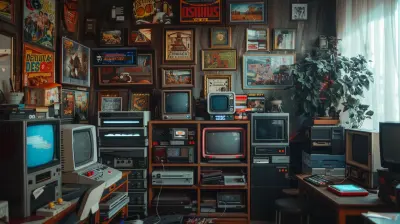Why Some Kickstarter Games Fail and Others Thrive
8 June 2025
So, you've got this brilliant idea for a game. It's innovative, it's fun, it's everything the gaming world needs. What do you do next? For many aspiring developers, the answer is Kickstarter. It’s like the golden stage where dreams meet potential backers. But here’s the catch: not all Kickstarter games make it big. In fact, some fizzle out before they even get off the ground. Ever wondered why some games soar to success while others quietly fade into obscurity? Let’s break it down.
The Big Idea: It's Not Always About the Idea
You might think the most important factor in a Kickstarter game's success is how amazing the idea is, right? Wrong. Yes, having a great concept is crucial, but it’s not the be-all and end-all. Sometimes, even the most genius game ideas fail on Kickstarter. Why? Because the idea alone doesn’t sell itself.Think about it this way: You may have the tastiest burger in town, but if no one knows your food truck exists, you’re not going to get any customers. Kickstarter is the same. You could have a groundbreaking concept for a game, but if you don’t know how to present or market it, it’s game over.
Lesson Learned:
A great idea won’t guarantee success — it’s how you package and sell the idea that truly matters. Backers need to see your vision, not just hear about it.
Communication Is Key: Telling Your Story
Why do some Kickstarter games rack up millions while others barely scrape by? A lot of it comes down to storytelling. People don’t just buy into games—they buy into the people and the passion behind them. If your campaign doesn’t tell a compelling story, it’s going to get lost in the crowd.Imagine scrolling through Kickstarter. Dozens of campaigns are vying for your attention. Which one do you click on? Probably one with clear, heartfelt messaging, right? A developer who takes the time to explain their journey, their struggles, and their vision will instantly connect with backers on a human level.
Example:
Take the wildly successful campaign for Shovel Knight. Yacht Club Games didn’t just pitch their game—they shared their love for retro gaming and communicated why their project mattered. That emotional connection turned casual browsers into die-hard backers.
Visuals Speak Louder Than Words
Let’s face it: Kickstarter is a visual platform. Nobody wants to scroll through walls of text. If you don’t hook people instantly with eye-catching visuals, they’ll scroll past without a second thought.High-quality concept art, gameplay footage, and even animations can breathe life into your campaign. On the flip side, grainy images or lackluster visuals send a strong message: “This campaign isn’t worth your money.” And let’s be honest, nobody wants to risk funding something that looks unpolished or half-baked.
Pro Tip:
Invest in good visuals. If that means hiring a graphic designer or an artist, go for it. Remember, this is the first impression people will get of your game. Make it count.
Setting Realistic Goals: Don’t Overpromise and Under-Deliver
One of the biggest reasons Kickstarter games fail is because developers bite off more than they can chew. Overpromising and under-delivering is a surefire way to lose the trust of your backers. Remember the fiasco with Mighty No. 9? On paper, it looked like the next big hit, but delays, budget overruns, and mediocre final quality left backers feeling burned.Now, let’s flip the coin. Those campaigns that thrive? They tend to set realistic goals. Developers who carefully plan out their budgets, timelines, and deliverables are far more likely to build trust and maintain it throughout the campaign.
Key Takeaway:
If you promise the moon and deliver a flashlight, you’re in trouble. Start small, stay transparent, and be honest about what you can (and can’t) achieve.The Power of Community: You Can’t Do It Alone
Here’s a secret sauce for Kickstarter success: community engagement. The most successful campaigns don’t just treat backers like wallets—they treat them like co-creators. Backers love feeling involved. They want to be a part of something bigger than themselves.Take Slay the Spire, for example. The developers used feedback from their community to fine-tune the game while it was still in development. This not only gave backers a sense of ownership but also helped create a better final product.
On the other hand, campaigns that ignore or dismiss their community’s input often struggle. Why? Because Kickstarter isn’t just about raising money—it’s about building relationships.
How to Build a Community:
- Start engaging with your audience early (social media, forums, etc.)- Actively respond to comments and questions on your Kickstarter page
- Involve backers in small decisions (like voting on artwork or features)
Marketing Roulette: If No One Knows, No One Cares
Let me drop a truth bomb: Even the best campaigns will fail if no one knows about them. Marketing is everything. Some projects gain traction because they already have an audience before they even hit Kickstarter. Others rely on word-of-mouth, influencers, or social media to spread the word.Now, here’s where things can go south. Some developers think, “I’ll just launch the campaign, and the backers will come.” Spoiler alert: They won’t. A lack of pre-launch marketing is one of the biggest reasons games fail. Without building hype beforehand, your campaign risks drowning in Kickstarter’s endless sea of projects.
Quick Tip:
Start building your audience months before your campaign goes live. Reach out to gaming communities, run social media ads, and collaborate with YouTubers or streamers who can spotlight your game.Timing Is Everything
Ever heard the phrase, “Timing is everything”? Turns out, it’s true for Kickstarter campaigns too. Launching at the wrong time can sink even the best projects. For example, launching during major gaming events (like E3 or Gamescom) could mean your campaign gets overshadowed by AAA game announcements.Conversely, launching at the right time—say, during a quiet period in the gaming calendar—can give you the attention you need. It’s all about understanding the landscape and choosing your moment wisely.
Stretch Goals: A Double-Edged Sword
Ah, stretch goals. They’re like dessert after dinner—tempting but risky. Done right, they can incentivize backers and boost your funding. But done wrong? They can derail your entire project.The problem with stretch goals is they can lead to scope creep. Adding too many additional features or promises can overwhelm developers and delay the game’s release. Backers get frustrated, trust erodes, and the campaign fizzles out.
Pro Tip:
Focus on a few realistic stretch goals. Keep them fun but achievable. You’re not trying to reinvent the wheel here.Why Do Some Games Thrive?
At this point, you might be asking, “So what’s the secret sauce for success?” While there’s no one-size-fits-all answer, thriving Kickstarter games tend to share these traits:- A Clear Vision: Successful campaigns communicate exactly what the game is about and why it matters.
- Transparency: Backers are kept in the loop every step of the way.
- Strong Community Engagement: Developers make backers feel like part of the journey.
- Solid Planning: Budgets, timelines, and deliverables are all realistic and well-thought-out.
- Pre-Launch Hype: A strong marketing push gets people excited and invested before the campaign even begins.
Final Thoughts
Kickstarter can be a fantastic platform for bringing creative game ideas to life, but it’s no cakewalk. Success requires more than just a great idea—it takes planning, storytelling, marketing, and, above all, connection. The hardest part? Balancing all these elements without dropping the ball.The good news is, every failure is a lesson. Each misstep teaches developers how to do better next time. And for every failed campaign, there’s another that rises like a phoenix, proving that with the right approach, dreams really can come true.
all images in this post were generated using AI tools
Category:
Kickstarter GamesAuthor:

Greyson McVeigh
Discussion
rate this article
3 comments
Karly Long
Success on Kickstarter requires innovation, passion, and community. Embrace the lessons from failures and let your creativity shine—your game could be the next big hit!
June 19, 2025 at 4:45 AM

Greyson McVeigh
Thank you for your insightful comment! I completely agree—innovation, passion, and community are key to Kickstarter success. Embracing lessons from failures can truly enhance creativity and increase the chances of making a standout game.
Naya Wright
Great insights! It’s fascinating how passion and planning can make or break a project. As a backer, I appreciate the transparency and creativity—can’t wait to see more success stories emerge from this vibrant community!
June 11, 2025 at 4:18 AM

Greyson McVeigh
Thank you! I'm glad you found the insights valuable. Your support and appreciation for transparency truly inspire us to keep sharing success stories!
Norah Pacheco
Like a cat in a cardboard box, some Kickstarter games just don’t know how to land! Let’s unravel the mysteries of funding fortune and feline finesse!
June 8, 2025 at 4:20 AM

Greyson McVeigh
Great analogy! It's fascinating to see how the right strategies can turn a potential flop into a success, much like a cat mastering the art of landing. Let’s explore those key elements!



